Description

The great quality of Quick Split in a running attack is that the defense really can't key on any one point to plug up because the handoff can go just about anywhere. With Speed Counter we use misdirection to get the defense flowing towards the offenses strong side, but then handoff in the opposite direction to let the halfback race through some hopefully open field. By using two halfbacks the right back should have the speed to get out in front of the ball carrier to lay a lead block. He may not have the size and power to crush a weakside linebacker the way a fullback might, but he should get out quickly enough to provide (legal) interference and let the other back use his speed to get outside.
Like almost any Quick Split running play Speed Counter works excellently with the Playmaker feature. The default setup gives you your best running threat against the weak side of the defense, while a simple flip of the assignments will give your second HB a chance behind the additional blocking of the slot wide receiver. Multiple WR motion options are also available to produce favorable matchups. One drawback is that despite the great flexibility of this play the personnel are a little light weight to hand tough base defenses, so it's best to mix in enough passes from the Quick Split formation to try and get your opponent into a Nickel defense.
Player Assignments
| Position | Action |
|---|---|
| O-Line and WRs | Run Block |
| QB | Handoff to Left RB |
| Left RB (RB #1) | Counter Step - Sweep Left |
| Right RB (RB #2) | Lead Far Left |
See the Madden Playbook Guide for a description of these symbols.
Blocking Assessment
To be effective with this play on a regular basis you need three things: good blocking WRs, a pair of backs with good speed, and the ability to read the defensive front seven. Speed is necessary because while this run can produce the occassional effective cutback to the inside it definitely does the most damage when the ball carrier gets to the corner behind strong WR and HB blocks. Having two backs with good speed is great because it makes runs in either direction a threat, though the #2 back on the right can get by okay on power instead of speed as he will tend to fight through more bodies on the strong side.
Before the snap read the D-line and LBs. If both units shift to the weak side then hit the Playmaker and go strong side with the #2 back. Otherwise stick with the run to the left. If the D-line spreads left or out wide but the LBs stay inside or shift strong side there could be a problem, the inside LB will penetrate after the HB lead block has gone by and could stuff the run in the backfield. This is a good situation to use WR motion to try and shake up the defense. In addition, pulling the left SE in a few steps tighter can give you an advantage in reaching the outside if the CB follows (in man coverage). In general try and reach the outside, but if both front seven units spread wide and the center is uncovered than look for a cutback to the middle behind a downfield block. This is less reliable, but can break the occassional big gain and is better than having the run strung out to the sideline.
Analysis
Pros:
- Explosive run with big gain capabilities
- Perfect Playmaker ability thanks to dual HBs
- Very effective against Nickel packages
Cons:
- Undersized personnel make play hit or miss against base defenses
- Requires specialized personnel (good blocking WR, two fast HBs) for consistent success
- Reliance on misdirection means occassional tackles for loss
Contact Arkaein with any comments or questions regarding the Monstrous Madden Playbook.